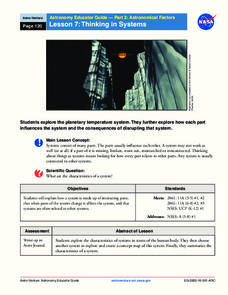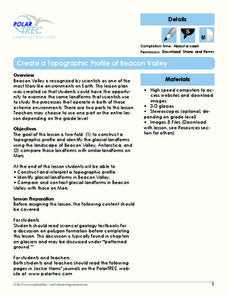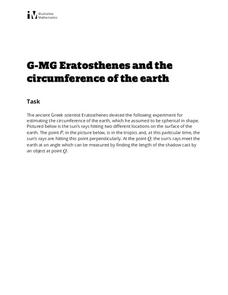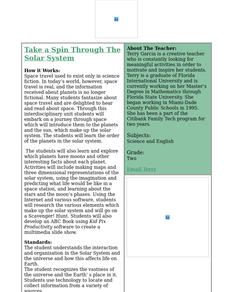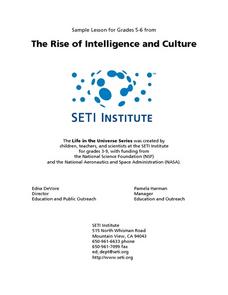NASA
Astronomy Mission Module
Yes, scientists say, there is other life in our solar system! And the best place to look is on Europa, a moon of Jupiter. Here, learners mimic the techniques scientists use to gather information about objects in our solar system, write...
Polar Trec
Create a Topographic Profile of Beacon Valley
Landforms in Beacon Valley, Antarctica, where there is no snow, bear a striking resemblance to landforms found on Mars. Scholars identify landforms found in Beacon Valley through analysis of topographic maps in the activity. They then...
Illustrative Mathematics
Eratosthenes and the Circumference of the Earth
The class gets to practice being a mathematician in ancient Greece, performing geometric application problems in the way of Eratosthenes. After following the steps of the great mathematicians, they then compare the (surprisingly...
National Institute of Open Schooling
Water Pollution
Fifteen million children under the age of five die each year due to diseases in their drinking water. Water pollution is the topic of lesson 34 in the series of 36. Scholars, through reading and discussing, study numerous aspects of...
Curated OER
Take a Spin Through the Solar System
Second graders participate in a variety of activities to explore the Solar System in this unit.
Curated OER
What are Stars?
Young scholars research the solar system and it's characteristics. In this solar system activity, students are broken into 4 groups, each assigned a specific part of the solar system. Young scholars use the Internet to...
Curated OER
Extraterrestrial Communication: Can We Talk to Anybody Out There?
Learners examine the possibilities of communication with other living organisms within our solar system through research and hands on activities, as well as observing and analyzing teacher demonstrations.
Curated OER
Outpost Communications Exercise
Pupils engage in a unique study of the solar system with the integration of technology in the form of e-mail. They communicate to each other on e-mail and give clues to an imaginary location without revealing the source the students must...
Curated OER
Atmospheric Shielding from Radiation III
In this radiation activity, students compare the efficiency of planetary atmospheres to shielding from radiation. This activity has 2 problems to solve.
Curated OER
Is There Ice on Mercury?
In this ice on Mercury worksheet, students read about the data collected from the NASA Messenger and the Arecibo Radio Telescope indicating the possibility of ice on Mercury. Students solve 6 problems including finding the scale of the...
Curated OER
Coronal Mass Ejections
In this coronal mass ejections worksheet, high schoolers observe a time line of events that took place during a solar storm. Students use the time line to answer 3 questions about the solar storm and the time it took to reach Earth. High...
Curated OER
Celestial Photography
High schoolers practice photographic skills and gain an awareness of photography as a scientific tool.
Curated OER
The Transit of Mercury
In this transit of Mercury worksheet, learners read about Earth and Mercury lining up so that Mercury passes across the disk of the sun from the Earth's view. Students solve 3 problems and they determine the diameter of the solar disk...
Curated OER
Motion Through the Ages
Eighth graders conduct internet research to produce a timeline of man's growth in understanding of concepts of motion and planetary motion through history.
Curated OER
Solar System
In this Solar System worksheet, 5th graders demonstrate knowledge of parts of the Solar System. Students unscramble letters to list these parts.
Curated OER
A Model of the Sun's interior
Young scholars create a three-dimensional model of the sun. For this solar system lesson, students design a scale model of the sun using plasticine.
Curated OER
Universal Gravitation Review
In this universal gravitation worksheet, students answer five questions about the speed of objects traveling in space, the speed of planets traveling around the sun and the weight of objects in space.
Curated OER
A DISAPPEARING ACT Astronomy: Do Stars Always Shine?
Learners observe why stars are not visible during the day with a classroom demonstration using an index card punched with holes.
Curated OER
Sunspots: Correlating Sunspots to Active Regions
Learners investigate sunspots. They use solar imaging from satellite instruments which are currently circling the sun. Students compare images from the satellites and determine the existence of a correlation between the two types of...
Curated OER
Galaxies Galore, Games and More
Students practice skills used in scientific investigation while studying the three main types of galaxies. Students identify Earth as part of Milky Way galaxy, the parts of galaxies, and the types of galaxies, as well as classify...
Curated OER
Planet/Constellation Mobile
Pupils, through small group discussion, identify and share a rationale for shapes and patterns in the construction of a mobile that represents the solar system that makes them think of the creation of our solar system.
Curated OER
Space: The Final Frontier
Sixth graders construct a graph to demonstration information that they've learned about the solary system. They also write or illustrate a sonar or lunar eclipse.
Curated OER
Please Ex-Planet
Seventh graders create a model of an earth centered solar system and a model of the sun centered solar system. As a class, they discuss why the earlier astronomers believed their model and why it changed when evidence arose that this...
Curated OER
Jupiter - King of the Planets
In this Jupiter worksheet, students read a passage about the environment and atmosphere of Jupiter. Students then answer several multiple choice questions about the passage.
Other popular searches
- Planets Outer Space
- Science Space and Planets
- Outer Space Outer Planets
- Poetry Space and Planets
- Planets and Space
- Space Planets Scale
- Space and Planets Practical
